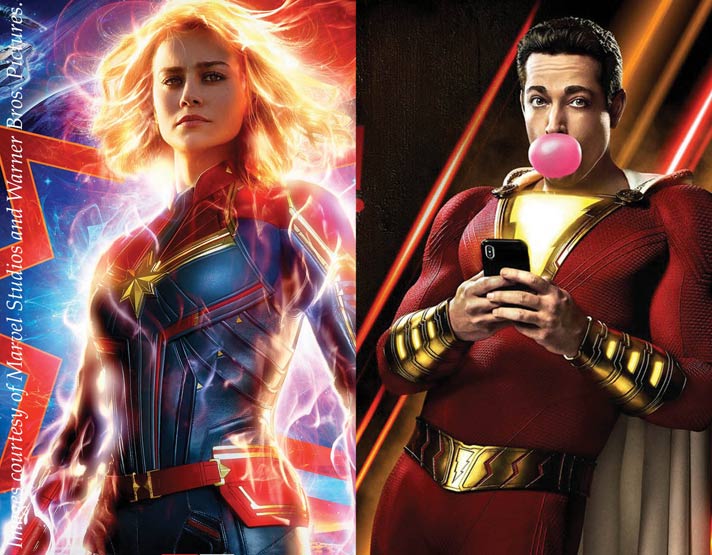The Unfettered Critic – April 2019
We recently saw the movie Captain Marvel.
Hold that thought—we’ll get back to it in a minute. But first: a few words about “comic book superhero” history. It’s complicated. Convoluted. Confusing.
And you thought it was just kid stuff!
In the 1930s, “pulp magazines” (named for the cheap wood pulp paper they were printed on) were very popular. William “Captain Billy” Fawcett was the founder of Fawcett Publications. The success of his initial publication, “Captain Billy’s Whiz Bang,” led to other Fawcett magazines, such as “Mechanix Illustrated” and “Family Circle.” Well, nothing succeeds like success, and soon countless competitors tried their hand at the pulp trade. Most important for our purpose here, was DC Comics, named for its 1938 title “Detective Comics,” and, in 1939, Marvel Comics, named after its first title, “Marvel #1.”
Also in 1938, a couple of kids working at DC Comics came up with a costumed character who could leap tall buildings in a single bound. They called him “Superman.” He was a hit. Not to be outdone, Fawcett created a costumed character whose astounding abilities were nearly indistinguishable from Superman’s, although his adventures were far more whimsical. Fawcett christened him (apparently with no thought of competitor Marvel Comics) “Captain Marvel.”
As might be expected, DC sued for character infringement, won their case, and acquired all rights to the Captain Marvel character, including use of the magic word—“Shazam”—that gave him his powers.
For several decades, DC Comics produced a line of Captain Marvel products—including comics and television shows—but, significantly, always branded them with the title “Shazam.” Eventually, Marvel Comics (remember them?) noticed that DC wasn’t using the name that was so close to their own, and saw an opportunity. Through a series of legalistic moves too twisted to delve into in this short column, Marvel Comics acquired the name Captain Marvel. Note: they acquired only the name. Not the character’s lightening-slashed costume, or his fictional history, or even his magic word. Just the name: Captain Marvel.
Over the years, Marvel Comics tried the moniker on various superhero types until—and this is significant—one day in 2012 they transformed him into her. (There’s much more to that story, but again, this poor little column…) Anyway, to the joy of some fans and disgust of others, Captain Marvel, superhero, became as curvaceous as she was…well…marvelous.
Now back to that movie we saw. Captain Marvel is about the female character, a nearly all-powerful female superhero. Remember 2017’s Wonder Woman? Yeah, like that, but a little more “on the nose.” Wonder Woman always was female, so there was no need to point it out. But now, in the era of “Me, Too,” and with the entertainment industry’s rather tardy realization that “Hey, women like superhero movies about female superheroes,” Captain Marvel is being marketed as a symbol of today, a hero(ine) for your daughters, etc.
Conclusion? It’s a good movie. Good script. Good performances. Good effects. And a kickass soundtrack based on hits from the ‘90s grunge music era. The plotline, centered on how the character acquired her powers, deserves your time and cost of admission.
But we felt we couldn’t review it without foisting all of that superhero publishing history upon you. Why? Because this month, a new movie will appear in theaters. It will be based on the original—male—Captain Marvel character. He’ll be wearing his original costume, and telling his original story. The title of that film? Shazam.
We don’t know whether we’ll review it, but you can bet we’ll be among the first in line to see it.

 Paula and Terry identify as writers, with an ever-increasing number of published works to support the supposition. They live a primarily pastoral life in the enchanted town of Jacksonville.
Paula and Terry identify as writers, with an ever-increasing number of published works to support the supposition. They live a primarily pastoral life in the enchanted town of Jacksonville.